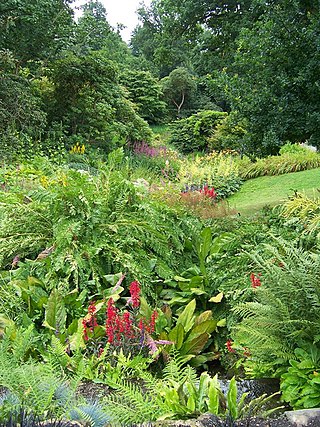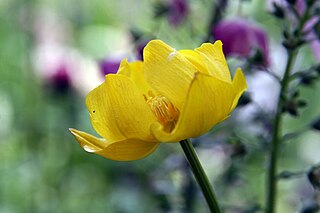
Aster is a genus of perennial flowering plants in the family Asteraceae. Its circumscription has been narrowed, and it now encompasses around 170 species, all but one of which are restricted to Eurasia; many species formerly in Aster are now in other genera of the tribe Astereae. Aster amellus is the type species of the genus and the family Asteraceae.

Ranunculaceae is a family of over 2,000 known species of flowering plants in 43 genera, distributed worldwide.

Trollius is a genus of about 30 species of flowering plants closely related to Ranunculus, in the family Ranunculaceae. The common name of some species is globeflower or globe flower. The generic name is derived from the Swiss-German word "Trollblume", meaning a rounded flower. Native to the cool temperate regions of the Northern Hemisphere, with the greatest diversity of species in Asia, Trollius usually grow in heavy, wet clay soils.

Trollius europaeus, the globeflower, is a perennial flowering plant of the family Ranunculaceae. The plant is native to Europe and Western Asia and is a protected species in Russia and Bulgaria.

A bog garden is a type of garden that employs permanently moist soil to create a habitat for plants and creatures which thrive in such conditions. It may exploit existing poor drainage in the garden, or it may be artificially created using pond liners or other materials to trap water in the area. Any such structure must allow a small amount of seepage to prevent the water stagnating. For instance, a pond liner must be pierced a few times. Typically a bog garden consists of a shallow area adjoining a pond or other water feature, but care must be taken to prevent water draining from a higher to a lower level. The minimum sustainable depth is 40–45 cm (16–18 in). Good drainage is provided by gravel placed over the liner, and the bog can be kept watered by using a perforated hose below the surface.

Trollius asiaticus, the Asian globeflower, is an ornamental plant of the family Ranunculaceae, which is native to Asia and Europe. This plant usually grows in wet places, especially in grasslands and forests. It commonly grows to about 20 cm or higher.

Tsaganomys altaicus is an extinct species of rodent from Asia, and the only species in the genus Tsaganomys.

The Altai snowcock is a species of bird in the family Phasianidae. It is found in western Mongolia and adjacent areas of China, Kazakhstan and Russia. Its natural habitat is boreal forests.
T. asiaticus may refer to:

The Botanischer Garten der Universität Regensburg is a botanical garden maintained by the University of Regensburg on campus at Universitätsstraße 31, Regensburg, Bavaria, Germany. It comprises 4.5 hectares. The garden is open daily except Saturday in the warmer months.
Causey Bank Mires is a Site of Special Scientific Interest in the Derwentside district of County Durham, England. It lies alongside and to the west of the Tanfield Railway, just under 1 km north of the Causey Arch.
Redcar Field is a Site of Special Scientific Interest in the Darlington district of County Durham, England. It is situated just north of Darlington, about 1 km south of the village of Coatham Mundeville.

Trollius laxus is a rare flowering plant species in the buttercup family, Ranunculaceae. It is native to North America and is considered to have two subspecies, one with a distribution is the east and one in the west. Common names for Trollius laxus include American globeflower and American spreading globeflower. The American Globeflower, Trollius laxus is an endangered species of flowering plants Native to Northeastern United States. This species of plants is limited in range by their ability to exclusively survive in wetlands and marshes. Thus, clusters of the species are constantly threatened by the ever-changing hydrology of the range they are confined to.
Erigeron altaicus is an Asian species of flowering plants in the family Asteraceae. It is native to Siberia, Kazakhstan, and Xinjiang.

Yulen is a nature reserve in Pirin National Park, located in the homonymous mountain range in south-western Bulgaria. It is situated in Bansko Municipality, Blagoevgrad Province. Yulen was declared on 26 August 1994 to monitor the growth of alpine plant species without human influence, as well as to protect rare plant and animal species. It spans a territory of 3156 ha or 31.56 km2.

Trollius × cultorum is a group of hybrid flowering plants of garden origin, belonging to the buttercup family Ranunculaceae. There are several cultivars, derived from T. europaeus, T. asiaticus and T. chinensis. These are clump-forming herbaceous perennials whose preferred location is heavy, moist or even boggy ground, in full sun or partial shade. Typically growing to 60 cm (24 in) tall, they bear showy double flowers up to 6 cm (2.4 in) in diameter. Flowers appear in shades of cream, yellow and orange. The curved “petals” are actually sepals, surrounding the smaller, nectar-bearing petals. The spherical or cupped shape of the blooms gives rise to the common name globeflower, which they share with other Trollius species.

Trollius yunnanensis, the Yunnan globeflower, is a species of globeflower, native to southern China; Gansu, Sichuan and Yunnan provinces, and to northern Myanmar. A perennial, it prefers to grow at elevations from 1,900 m up to 3,900 m on grassy slopes and wet meadows. It has gained the Royal Horticultural Society's Award of Garden Merit.

Aster altaicus is a species of plant belonging to the family Asteraceae.

Trollius chinensis, the Chinese globeflower, is a species of flowering plant in the family Ranunculaceae, found from southern Siberia to the southern Russian Far East, Sakhalin, the Kurils, Mongolia, Korea, and northern China. Its cultivar 'Golden Queen' has gained the Royal Horticultural Society's Award of Garden Merit.
















